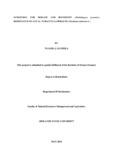Please use this identifier to cite or link to this item:
https://cris.library.msu.ac.zw//handle/11408/2149| Title: | Screening for disease and rootknot (Meloidogyne Javanica) resistance on local tobacco landraces (Nicotiana Tabacum l.) | Authors: | Kavhiza, Nyasha J. | Keywords: | Meloidogyne javanica Nicotiana tabacum L |
Issue Date: | 2016 | Abstract: | Thirty local tobacco landraces collected from non-traditional tobacco belt of Zimbabwe, such as Binga, Mutoko and Masvingo were screened for resistance against Tobacco Mosaic Virus (TMV), Potato Virus Y (PVY) and rootknot nematodes (RKN). The thrust of the study was to assess the level of resistance of the landraces to these major diseases of economic importance in tobacco. A standard flue cured tobacco (FCT) variety KE1, which is susceptible to all tobacco diseases was used as a positive control. The landraces were raised in the greenhouse where standard cultural and maintenance procedures were carried out. The specimens were then artificially inoculated for TMV, PVY and RKN then assessed for resistance. Significant genotypic variation was observed amongst the landraces. There were significant differences (P<0.001) in TMV severity, PVY severity and rootknot galling. The study revealed that 18 of the landraces have a hypersensitive response type of resistance to TMV, whilst 3 of the 12 susceptible landraces had severity percentages as high as 100% each. In PVY significant differences were noted (P<0.001) and four of the landraces did not exhibit any symptoms of PVY, showing immunity, hence a severity of 0. Most of the susceptible landraces were moderate in terms of severity as shown by a grand mean of 0.5931. The highest significant severity was observed in 8 landraces including Chokotwani and Chinyoka had severities of 1, comparable to KE1 which exhibited necrotic symptoms. PVY severity therefore ranged from a lowest of 0 to a peak of 1. For (RKN) assessment there were significant differences amongst the means. Two landraces namely Bhabhane and Unknown 2 had gall scores below 2. They had scores of 1.333 and 1.667 respectively, which shows very low nematode infection. Rupadza had the highest gall score of 6.33 comparable to KE1 with a mean of 7. The landrace Bhabhane had an outstanding overall performance when put under selection pressure of the 3 diseases. Potential sources of resistance to TMV, PVY and RKN were identified in this experiment. The disease resistance genes from the landraces can therefore complement already existing resources for elite tobacco breeding in Zimbabwe. | URI: | http://hdl.handle.net/11408/2149 |
| Appears in Collections: | Bsc Horticulture Honours Degree |
Files in This Item:
| File | Description | Size | Format | |
|---|---|---|---|---|
| NYASHA DISSERTATION.pdf | 605.71 kB | Adobe PDF |  View/Open |
Page view(s)
250
checked on Jan 10, 2026
Download(s)
134
checked on Jan 10, 2026
Google ScholarTM
Check
Items in MSUIR are protected by copyright, with all rights reserved, unless otherwise indicated.



